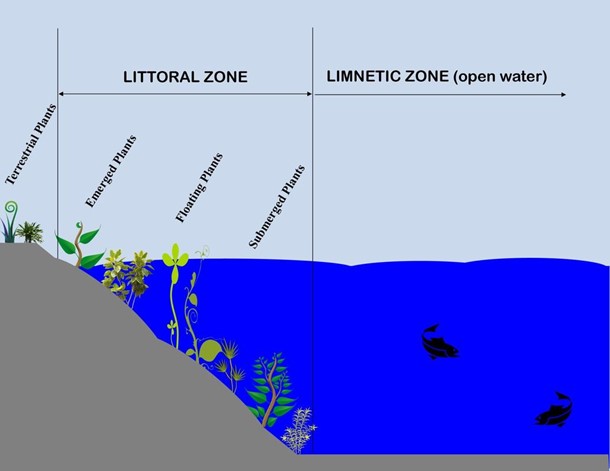This blog is intended to explain the function and importance of littoral vegetation in stormwater ponds and provide a reference for Florida-Friendly plant species that do well in each littoral zone.
A stormwater pond’s main function is to provide flood control for urban areas, and they are very effective at doing so.
As stormwater moves through the urban environment it can pick up a variety of contaminants like:
- landscape debris
- lawn fertilizer
- litter and trash
- pesticides
- vehicular fluids (oil, grease, coolant, gasoline, etc)
- sediments
A secondary function of these ponds is to absorb and treat some of these urban contaminants. Shoreline and littoral vegetation is one way to enhance these ponds’ treatment abilities (Nighswander, Gisele P., et al. 2019).

The littoral zone of a pond is where land and water converge, technically defined by the area in the pond where the sunlight reaches the sediment. This zone is organized by various depths: upper, middle, and lower zones. The upper littoral zone is closest to the shoreline and characterized by exposed wet soil or shallow water. Emergent wetland plants are best for this area. They root in the soil and along the bank with most of the plant above the water.
The middle littoral zone is better for floating wetland plants since this area is consistently submerged. Floating wetland plants are anchored in the soil but also have dangling roots.
Lastly, the lower littoral zone has the deepest water and provides a habitat for completely submerged plants (Hansen & Hu 2019).
Functions of Littoral Vegetation
Shoreline plants reinforce bank slopes with root systems, block litter from entering the pond, slow incoming water to allow suspended sediment to settle, and absorb nutrients from decomposing landscaping waste or fertilized lawns. Plants within the littoral zone can extract excess nutrients and heavy metals from both the soil and the water column decreasing the chance of algae blooms and storing those excess nutrients before they have the chance to move downstream. Established littoral vegetation can also decrease nuisance invasive species by occupying the area they would normally try to establish themselves. Aside from these impacts, the visual quality of a pond can be enhanced with stormwater pond plants (Nighswander, Gisele P., et al. 2019).
Take a look at the before and after below:

Choosing the right plants for each zone
Choosing the correct aquatic plant species for a pond is no easy task. These plants have specific preferences for things like water depth, sunlight, soil conditions, and temperature. Another thing to keep in mind is how they look. Some plants are short and bushy, some are sprawling vines, some bloom and go dormant, and others can be evergreen (Nighswander, Gisele P., et al. 2019).
Table 1: Recommended plants for stormwater pond shorelines
| Water edge zone | ||||
| Plant | Height | Light | Water depth | USDA zone |
| Arrowhead
Sagittaria latifolia |
3.5′ | Full sun to partial shade | 6″–12″ | 5–10 |
| Blue flag iris
Iris virginica |
2′ | Partial shade | Moist to wet; water edge | 8b–11 |
| Duck potato
Sagittaria lancifolia |
3′ | Full sun to partial shade | 6″–12″ | 6–10 |
| Fragrant water lily
Nymphaea odorata |
Floating | Full sun to partial shade | 30″–36″ | 8a–11b |
| Golden canna
Canna flaccida |
3′ | Full sun to partial shade | 12″–18″ | 8–10 |
| Pickerelweed
Pontederia cordata |
3′ | Full sun to partial shade | 6″–18″ | 3b–10 |
| Sand cord grass
Spartina bakerii |
4′ | Full sun | Dry to wet; water edge | 8b–11 |
| Spikerush
Eleocharis cellulosa & interstincta |
2.5′ | Full sun to partial shade | 6″–12″ | 8a–11b |
| Swamp lily
Crinum americanum |
2′ | Partial shade | 3″ | 7–11 |
| Bank slope zone | ||||
| African iris
Dietes iridioides |
3′ | Full sun to partial shade | Dry to wet | 8b–11 |
| Blue mistflower
Conoclinium coelestinum |
2′ | Full sun to partial shade | Moist | 4–11 |
| Blue porterweed
Stachytarpheta jamaicensis |
2′ | Full sun | Dry to moist | 9–11 |
| Fakahatchee grass
Tripsacum dactyloides |
4′ | Full sun to partial shade | Dry to moist | 8–11 |
| Florida gamagrass
Tripsacum floridanum |
3′ | Full sun to partial shade | Dry to wet | 8–11 |
| Muhly grass
Muhlenbergia capillaris |
3′ | Full sun | Dry to wet | 7–11 |
| Passion vine
Passiflora incarnata |
0.5′ | Full sun | Moist | 8–11 |
| Scorpion tail
Heliotropium angiospermum |
1.5′ | Full sun to partial shade | Dry | 10-11
|
Source: Gail Hansen and Shangchun Hu “Florida-Friendly plants for stormwater pond shorelines” https://edis.ifas.ufl.edu/publication/EP476
This table is just a small set of plants that can be used for this application. If you would like to dive deeper into this subject, there is a much larger and very detailed database available through the Institutional Repository at the University of Florida at: http://ufdc.ufl.edu/IR00010631/00001. This database also has an accompanying EDIS publication to explain its use so that you can make educated decisions about plant selection.
Finally, it is always a good idea to check with your HOA, county, and local water management district before planting in your local stormwater pond.
Works Cited
Hansen, Gail, and Shangchun Hu . “Florida-Friendly Plants for Stormwater Pond Shorlines.” Ask Ifas, University of Florida , 8 May 2019, edis.ifas.ufl.edu/publication/EP476.
https://edis.ifas.ufl.edu/publication/EP476
Nighswander, Gisele P., et al. “A New Database On Trait-Based Selection of Stormwater Pond Plants.” Ask Ifas, University of Florida , 18 July 2019, edis.ifas.ufl.edu/publication/fr416
https://edis.ifas.ufl.edu/publication/fr416
 0
0
